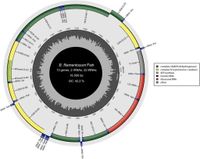The order Siluriformes, widely recognized for its catfish species, is the focus of a comprehensive new study that unveils the complete mitochondrial genome of the Piraíba catfish, Brachyplatystoma filamentosum, the largest catfish in the Amazon. This significant research dives deeper into the evolutionary dynamics of body size in Siluriformes and reveals critical insights into how environmental factors may shape body size evolution.
The study’s findings indicate that the mitochondrial DNA of the Piraíba measures 16,566 base pairs in length with a GC content of 42.21%. Furthermore, phylogenetic analysis using this mitogenome alongside data from 137 other Siluriformes species has estimated the origins of this order to be around 118 million years ago. The research delineates the diversification timeline of the catfish, noting that the suborder Loricarioidei emerged first, succeeded by Diplomystoidei and Siluroidei, with the latter experiencing a rapid expansion approximately 94 million years ago.
One impetus for this groundbreaking research is the striking diversity of body sizes within Siluriformes, which ranges from diminutive species measuring just a few centimeters to the towering Piraíba reaching lengths of more than 3 meters. Notably, the research documented an upward trend in body size evolution, observing 16 positive and 11 negative patterns in size changes through evolutionary time, underscoring a lack of a significant global trend towards large or small sizes among these fish.
Experts have long theorized various patterns directing the evolution of body size across species and ecosystems. This study not only broadens this discourse but also fits into a larger narrative regarding the impacts of environmental changes on biodiversity. The authors concluded that the evolution of body size in the Siluriformes appears both influenced by ecological factors, like temperature and habitat, as well as other biological interactions.
Piraíba catfish, known extensively for their size and economic importance, highlight the crucial need for further research into their biology and conservation strategies. Overfishing has heavily impacted natural stocks, and research like this serves to advocate for sustainable management and conservation efforts of such vital species in the Amazon Basin.
To achieve these resolutions, researchers sequenced the mitogenome using advanced techniques from both PacBio and Illumina technologies, demonstrating high concordance in data across methodologies, showcasing a thorough quality check across samples. This highlights the significant technological advancements facilitating genomic studies in aquatic biodiversity.
In their findings, the research also illustrates that rapid changes in water temperature seem to correlate with shifts in body size, consistent with documented ecological rules like Bergmann’s rule. While the study identifies myriad evolutionary pressures that act upon the Siluriformes, it also argues the critical importance of anchoring genetic study with ecological understanding to acknowledge the ongoing changes in the environment, particularly due to climate change and human activity.
The evolutionary trajectory of Siluriformes, particularly through the lens of size dynamics, reveals broader patterns that can inform future research directions in evolutionary biology and conservation. Overall, by mapping out these evolutionary pathways, this study contributes significantly to understanding how intricate relationships among species, their environments, and their evolutionary histories shape biodiversity.




